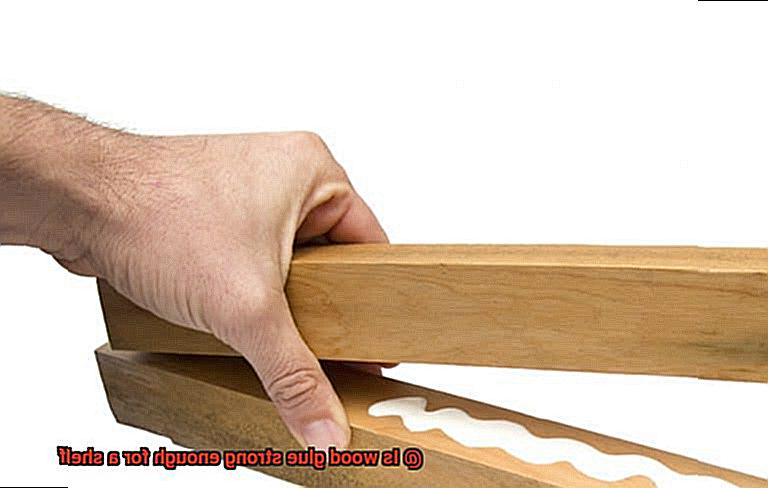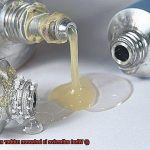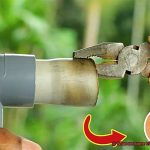Today, we’re diving into the age-old debate: is wood glue alone strong enough to hold up a shelf? As someone who’s spent countless hours in the workshop, I’m here to give you the lowdown. Now, before you grab that bottle of wood glue and start building, let’s explore the factors that come into play.
First things first, the type of wood you choose for your shelf makes a big difference. Think of it like this: hardwoods like oak and maple are the tough guys of the wood world. They can handle some serious weight without breaking a sweat. On the other hand, softer woods like pine or plywood might need a little extra help to keep things sturdy. The density and grain structure of the wood directly impact how well that glue bond holds up.
But wait, there’s more. Size matters when it comes to shelves too. If you’re thinking about whipping up a cute little wall-mounted display for your knick-knacks, wood glue might be all you need. Those smaller shelves don’t have much weight to bear, so a strong glue bond can do the trick. However, if you’re planning on creating a behemoth bookshelf or something that’ll hold heavier objects, you might want to consider reinforcements.
Now let’s talk about how you plan on using your shelf. Are you going to be moving it around often? Will it face some serious wear and tear? If so, my friend, it’s time to bring in some backup support mechanisms like screws or brackets. Adding these extra elements will give your shelf that extra oomph it needs to withstand whatever life throws its way.
Oh boy, we’re not done yet. Proper application is key when it comes to making sure that wood glue bond holds strong. Clean surfaces? Check. Flat as can be? Check. And don’t forget to apply some pressure during the curing process, whether it’s using clamps or just a good ol’ heavy book. Give that glue some time to dry and do its thing, and you’ll have yourself a bond that’s hard to break.
To sum it all up, wood glue can be a real game-changer when it comes to building sturdy shelves. But remember, there are a bunch of factors at play here. The type of wood, the size and design of your shelf, how you plan on using it, and proper application techniques
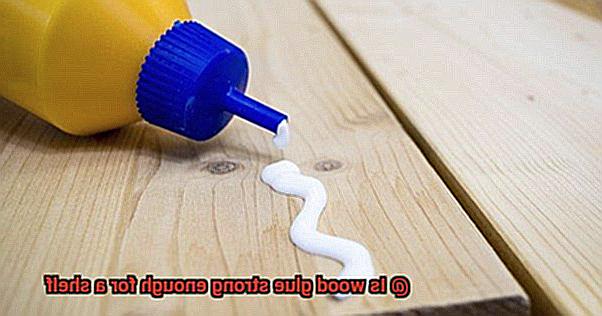
Different Types of Wood Glue
Contents
- 1 Different Types of Wood Glue
- 2 The Strength of the Bond Depends on the Quality and Brand
- 3 Consider the Type of Wood Being Used for the Shelf
- 4 Proper Surface Preparation Before Applying Wood Glue
- 5 Applying the Right Amount of Wood Glue
- 6 Allow Sufficient Drying Time Before Subjecting to Heavy Loads
- 7 Additional Reinforcement Methods for Extra-Strength Bonds
- 8 Conclusion
PVA (Polyvinyl Acetate) Glue:
PVA glue, the most commonly used wood glue, is perfect for shelf construction. This water-based adhesive is easy to work with and dries clear, ensuring a seamless finish. PVA glue is non-toxic and offers a strong bond when applied correctly. It is suitable for most woodworking applications, including shelves. However, it may not be as strong as other glues and may not hold up well under heavy loads.
Epoxy Glue:
Epoxy glue, consisting of a resin and a hardener, forms an incredibly strong bond that withstands heat, chemicals, and moisture. It is an excellent choice for shelves that will be subjected to heavy loads or harsh environments. However, epoxy glue can be more challenging to handle compared to PVA glue and requires careful mixing and application.
Polyurethane Glue:
Polyurethane glue is moisture-activated and expands as it cures, creating a powerful bond that fills gaps. It is resistant to heat and moisture, making it suitable for outdoor applications. Polyurethane glue is particularly useful for shelves that may be exposed to water or temperature changes. However, it can be messy to work with and requires clamping during the curing process.
Cyanoacrylate Glue:
Cyanoacrylate glue, commonly known as superglue or CA glue, provides an instant bond and is ideal for small repairs or joining delicate pieces of wood. While it can be effective in certain situations, it may not have the same strength as other wood glues and may not be suitable for long-term shelf construction.
Specialty Wood Glues:
There are also specialty wood glues available for specific applications. For instance, there are glues designed for veneering or laminating wood, as well as glues formulated for use with exotic or oily woods that may be challenging to bond with standard wood glues. These specialty glues offer unique properties and strengths tailored to specific woodworking needs.
In summary, the choice of wood glue for shelf construction depends on various factors such as the intended use of the shelf, the type of wood, and any environmental considerations. PVA glue is the most commonly used and suitable for most woodworking applications. However, for projects requiring a stronger bond or specific environmental considerations, epoxy, polyurethane, or specialty wood glues may be a better option.
The Strength of the Bond Depends on the Quality and Brand
The strength of the bond between quality and brand is a critical factor in determining the reliability and performance of a product. When it comes to wood glue and its ability to secure a shelf, the quality and brand of the glue used can significantly impact the durability and longevity of the bond.
Not all wood glues are created equal, and different brands offer varying levels of strength and adhesive properties. Reputable brands understand the importance of providing a product that delivers exceptional performance, which is why they invest in research and development to create formulations that offer superior bonding strength.
To ensure you select a high-quality wood glue, it’s essential to consider industry standards and certifications. Look for glues labeled as ANSI/HPVA Type I or Type II, indicating their ability to withstand specific levels of stress and moisture. These certifications provide assurance that the glue has been tested and proven to meet certain performance criteria.
In addition to certifications, seeking recommendations from professionals or experienced woodworkers who have tested different brands can be invaluable. They can provide insights into the strength and reliability of various wood glues based on their personal experiences.
When choosing the appropriate wood glue for a shelf, it’s crucial to consider the specific requirements of the shelf itself. Factors such as weight capacity, the type of wood used, and the overall design of the shelf can influence the necessary strength of the bond. For lightweight shelves used for decorative items or holding lightweight objects, standard wood glue may be sufficient. However, for heavy-duty shelves that bear significant weight or endure frequent use, stronger adhesives like epoxy or polyurethane glue are advisable.
Consider the Type of Wood Being Used for the Shelf
The type of wood being used for a shelf is a crucial factor to consider when determining whether wood glue is strong enough. The density, hardness, grain structure, quality, thickness, and width of the wood all play a significant role in the strength and durability of the glue joint.
Firstly, the density and hardness of the wood are essential considerations. Hardwoods like oak, maple, and walnut are known for their strength and durability. They have a higher density and hardness compared to softwoods like pine or cedar. This means that hardwoood shelves are generally stronger and more capable of withstanding heavy loads without warping or splitting.
Additionally, the grain structure of the wood is important. Hardwoods have tighter grain patterns, making it easier for the glue to penetrate and create a strong bond. Softwoods, on the other hand, have looser grain structures, which can make it more challenging for the glue to form a secure bond.
The quality of the wood also affects the strength of the shelf. Lower-grade or inferior-quality wood may have knots, cracks, or other imperfections that weaken the overall structure. Even with the strongest wood glue, these flaws may compromise the integrity of the shelf.
Furthermore, the thickness and width of the wood impact the strength of the glue joint. Thicker pieces provide a larger surface area for the glue to bond to, resulting in a stronger connection. Similarly, wider boards offer more contact area for the adhesive to adhere to, enhancing the overall strength of the joint.
Proper surface preparation is crucial for achieving a strong bond. The mating surfaces should be clean, dry, and free from any dirt, dust, or oils that could interfere with the bonding process. Sanding or planing the surfaces can also help create a smoother and more even joint.
While wood glue can provide a sufficient bond for many applications, additional reinforcement methods such as screws or dowels may be recommended for shelves that will bear heavy loads or experience frequent movement.
Proper Surface Preparation Before Applying Wood Glue
Proper surface preparation is crucial for achieving a strong and durable bond when applying wood glue to build a shelf. Here are the necessary steps to ensure optimal results:
- Cleanliness: Before applying wood glue, it is essential to have clean surfaces. Use a clean cloth or a vacuum cleaner to remove any dust, dirt, or debris that can hinder proper adhesion.
- Dryness: Moisture can weaken the adhesive bond, so make sure the surfaces are completely dry before applying the glue. Allow them to air dry naturally or use a hairdryer on a low heat setting to speed up the process.
- Smooth and even surfaces: Sand the wood surfaces with fine-grit sandpaper to achieve a smooth finish. This step eliminates any rough or uneven spots that can compromise the strength of the joints. Remember, the smoother the surfaces, the better the glue adhesion.
- Proper alignment: Ensure that the wood pieces fit together tightly and are properly aligned. Use clamps or other securing methods while the glue dries to prevent any movement and ensure a strong bond.
- Even glue application: Apply an even coat of wood glue to both surfaces being glued together. Using too much glue can result in excess squeeze-out and weak joints, while using too little may lead to inadequate bonding. Follow the manufacturer’s instructions regarding application and drying times for optimal results.
- Specific product recommendations: Different types of wood glues may have specific requirements for surface preparation. Consult the product’s instructions or seek advice from a woodworking expert if you are unsure about the particular requirements.
Applying the Right Amount of Wood Glue
When it comes to applying the right amount of wood glue, there are several important factors to consider. By understanding these factors and following a few guidelines, you can ensure a successful shelf project that is sturdy, visually appealing, and built to last.
First and foremost, the strength and stability of your shelf depend on the amount of glue applied. Too little glue can result in weak bonds that may easily break over time. This compromises the overall durability of the shelf, making it prone to damage or collapse. On the other hand, excessive squeeze-out of glue can create a messy and unappealing appearance on the shelf. It can also be difficult to remove dried excess glue without damaging the wood surface. To strike the perfect balance, apply a thin, even layer of glue on both surfaces being joined. This ensures proper coverage while minimizing the risk of excessive squeeze-out.
The type of wood being used for your shelf also plays a significant role in determining the right amount of glue. Different types of wood have varying levels of porosity. Some woods are more porous and absorbent, while others are denser and less porous. This affects how much glue is needed for effective bonding. For example, more porous woods may require slightly more glue to ensure optimal bonding, while dense hardwoods may require less due to their lower porosity.
In addition to applying the right amount of glue, proper clamping is crucial for creating a strong bond between the glued surfaces. Applying even pressure using clamps helps to ensure that the joint is held securely in place while the glue dries. This promotes an even distribution of pressure, enhancing the overall strength and stability of the shelf.
Once you have applied the wood glue and clamped the joint, it is important to wipe off any excess glue immediately with a damp cloth or sponge before it dries. Dried glue can be difficult to remove and may affect the overall appearance of the shelf.
Finally, allowing sufficient drying time is crucial for the wood glue to fully cure and create a strong bond. The drying time can vary depending on factors such as temperature, humidity, and the specific type of wood glue used. It is advisable to consult the manufacturer’s guidelines for the recommended drying time.
Allow Sufficient Drying Time Before Subjecting to Heavy Loads
Allow Sufficient Drying Time Before Subjecting to Heavy Loads
Wood glue, the superhero of woodworking, possesses the power to create bonds stronger than the wood itself. It’s no wonder it’s a top choice for building shelves. However, even the mightiest bond needs time to mature before it can bear heavy loads.
Drying time for wood glue varies depending on the type of glue and environmental conditions. It’s crucial to let the wood glue dry for a minimum of 24 hours before subjecting it to heavy loads. This allows the glue to cure fully and reach its maximum strength.
During this critical drying period, the glued joint must be treated with utmost care. Any movement or stress can weaken the bond, compromising the strength of your shelf. So, resist the temptation to test its limits too soon and exercise patience.
Always refer to the manufacturer’s instructions regarding drying time. Some wood glues may require longer periods, especially those designed for high-stress applications. When in doubt, err on the side of caution and give it extra drying time.
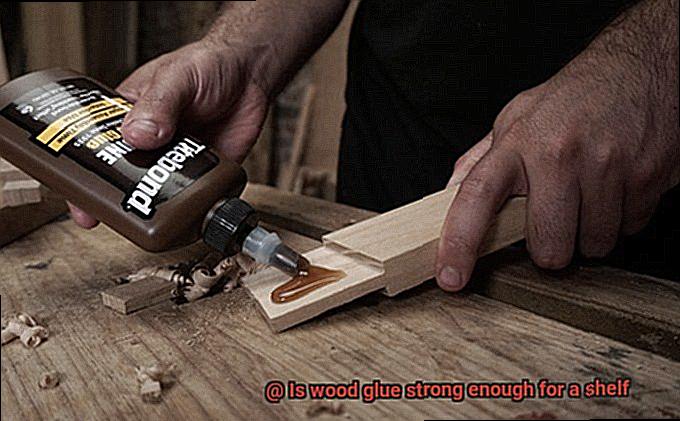
Thickness and wood type also play a role in drying time. Thicker joints and denser woods demand more time compared to thinner joints and softer woods.
Once the wood glue has fully dried, it will deliver a robust and durable bond capable of supporting heavy loads on your shelf. Grant your wood glue the time it needs to unleash its magic, and you’ll be rewarded with a steadfast shelf that can withstand anything.
Additional Reinforcement Methods for Extra-Strength Bonds
When it comes to creating extra-strength bonds for shelves, there are several reinforcement methods that can be employed. These methods go beyond just relying on the curing time of wood glue and provide additional support to ensure the shelves are sturdy and capable of withstanding heavy loads.
One commonly used reinforcement method is the combination of screws or nails with wood glue. By applying wood glue to the joints and then securing them with screws or nails, a double bond is created that adds strength and stability to the shelf. This method is particularly effective when working with heavier materials or when the shelf will be subjected to significant weight or stress.
Another option for reinforcing shelves is the use of dowels or biscuits. Dowels are cylindrical wooden rods that can be inserted into pre-drilled holes in the joints, while biscuits are small oval-shaped pieces of compressed wood that are placed in slots cut into the joints. Both dowels and biscuits provide additional surface area for the wood glue to adhere to, enhancing the strength of the joints and preventing separation under load.
To reinforce the corners of shelves, corner brackets or metal L-brackets can be used. These brackets can be attached to both the vertical and horizontal components of the shelf, creating a strong connection that prevents wobbling or sagging. Securing the brackets with screws or nails and applying wood glue further strengthens the bond.
For shelves that need to bear particularly heavy loads, incorporating a dado joint into the design is recommended. A dado joint involves cutting a groove into one piece of wood and fitting another piece into that groove. This creates a larger gluing surface area and enhances the overall strength of the bond. Additionally, dado joints help prevent sagging over time by providing additional support for the weight.
For those seeking maximum reinforcement, a combination approach can be used. This involves employing multiple reinforcement methods simultaneously, such as using dowels or biscuits in conjunction with screws or nails. By creating multiple points of connection, the overall strength and stability of the shelf are further enhanced.
Conclusion
In conclusion, wood glue has the potential to be a powerhouse when it comes to holding up shelves. But don’t jump the gun just yet – there are several crucial factors that demand your attention. The type of wood you choose for your shelf is like the backbone of its strength. Hardwoods such as oak and maple flex their muscles and can handle hefty loads, while softer woods like pine or plywood might buckle under pressure.
Size matters, my friend. A petite shelf with lightweight demands might find solace in the arms of wood glue alone. However, if you’re dealing with a hulking shelf or one that needs to carry weighty objects, reinforcements like screws or brackets should enter the picture.
Don’t even think about slapping on that wood glue without proper preparation. Cleanliness is key here – surfaces need to be squeaky clean, flat as a pancake, and devoid of any dirt or oils that could sabotage adhesion. And let’s not forget about applying some serious muscle during the curing process – clamps or heavy objects will lend a helping hand in creating an ironclad bond.
The quality and brand of your chosen wood glue can make all the difference. Trustworthy brands put their blood, sweat, and tears into research and development to concoct formulations that offer Herculean bonding strength. Look out for industry certifications like ANSI/HPVA Type I or Type II – they’re like badges of honor that guarantee performance.
In a nutshell (or should we say “in a timber frame”?), while wood glue can certainly be up to snuff for most shelf projects, it would behoove you to take into account the unique requirements of your shelf and select an appropriate type of wood glue accordingly.

